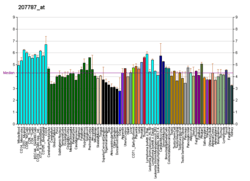Keratin, type I cuticular Ha3-II is a protein that in humans is encoded by the KRT33B gene.[3][4][5]
The protein encoded by this gene is a member of the keratin gene family. It is one of the type I hair keratin genes which are clustered in a region of chromosome 17q12-q21 and have the same direction of transcription. As a type I hair keratin, it is an acidic protein which heterodimerizes with type II hair keratin to form hair and nails. There are two isoforms of this protein, encoded by two separate genes, KRTHA3A and KRTHA3B.[5]
References
- 1 2 3 ENSG00000131738 GRCh38: Ensembl release 89: ENSG00000263012, ENSG00000131738 - Ensembl, May 2017
- ↑ "Human PubMed Reference:".
- ↑ Rogers MA, Schweizer J, Kreig T, Winter H (Nov 1995). "A novel human type I hair keratin gene: evidence for two keratin hHa3 isoforms". Mol Biol Rep. 20 (3): 155–61. doi:10.1007/BF00990548. PMID 7565656.
- ↑ Schweizer J, Bowden PE, Coulombe PA, Langbein L, Lane EB, Magin TM, Maltais L, Omary MB, Parry DA, Rogers MA, Wright MW (Jul 2006). "New consensus nomenclature for mammalian keratins". J Cell Biol. 174 (2): 169–74. doi:10.1083/jcb.200603161. PMC 2064177. PMID 16831889.
- 1 2 "Entrez Gene: KRT33B keratin 33B".
Further reading
- Yu J, Yu DW, Checkla DM, et al. (1993). "Human hair keratins". J. Invest. Dermatol. 101 (1 Suppl): 56S–59S. doi:10.1111/1523-1747.ep12362635. PMID 7686952.
- Rogers MA, Winter H, Wolf C, et al. (1998). "Characterization of a 190-kilobase pair domain of human type I hair keratin genes". J. Biol. Chem. 273 (41): 26683–91. doi:10.1074/jbc.273.41.26683. PMID 9756910.
- Langbein L, Rogers MA, Winter H, et al. (1999). "The catalog of human hair keratins. I. Expression of the nine type I members in the hair follicle". J. Biol. Chem. 274 (28): 19874–84. doi:10.1074/jbc.274.28.19874. PMID 10391933.
- Strausberg RL, Feingold EA, Grouse LH, et al. (2003). "Generation and initial analysis of more than 15,000 full-length human and mouse cDNA sequences". Proc. Natl. Acad. Sci. U.S.A. 99 (26): 16899–903. doi:10.1073/pnas.242603899. PMC 139241. PMID 12477932.
- Anderson NL, Polanski M, Pieper R, et al. (2004). "The human plasma proteome: a nonredundant list developed by combination of four separate sources". Mol. Cell. Proteomics. 3 (4): 311–26. doi:10.1074/mcp.M300127-MCP200. PMID 14718574.
- Gerhard DS, Wagner L, Feingold EA, et al. (2004). "The status, quality, and expansion of the NIH full-length cDNA project: the Mammalian Gene Collection (MGC)". Genome Res. 14 (10B): 2121–7. doi:10.1101/gr.2596504. PMC 528928. PMID 15489334.
- Ewing RM, Chu P, Elisma F, et al. (2007). "Large-scale mapping of human protein-protein interactions by mass spectrometry". Mol. Syst. Biol. 3 (1): 89. doi:10.1038/msb4100134. PMC 1847948. PMID 17353931.
|
|---|
| Human | |
|---|
| Nonhuman | |
|---|
See also: cytoskeletal defects |


